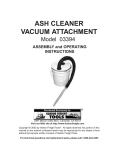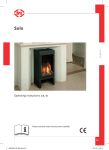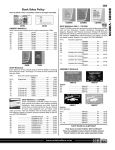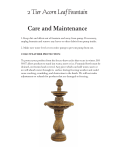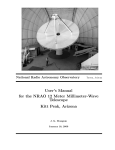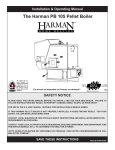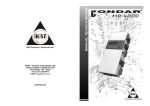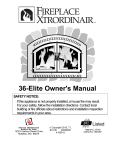Download Care and Replacement Manual for Woodstove Catalytic
Transcript
Care and Replacement Manual for Woodstove Catalytic Combustors A good combustor is designed to withstand approximately 12,000 hours of continuous use. For most people, this will translate into five to ten years of use, depending on the length of your heating season and how often you use your stove. Proper maintenance will increase the combustor’s effectiveness and prevent many problems. Inspect your combustor before each heating season, and during the season if your stove’s performance seems to change. There are some obvious signs of trouble that your inspection may reveal. Contents Inspecting your combustor 2 How to tell when you need a new combustor 4 Cleaning your combustor 6 Tips to extend combustor life 7 Burn smarter and protect your combustor 7 Buying a replacement combustor if needed 8 Condar Company PO Box 250, Columbus NC 28722-0250 phone (828) 894-8383 · fax (828) 894-2718 www.Condar.com copyright © 2006 Condar Company All rights reserved Inspecting your combustor Ash, a fluffy light grey powder, and soot, a darker granular material, accumulate on the combustor surfaces in normal use. Ashes accumulate both as a result of the smoke being burned within the combustor and by being carried out of the firebox by the chimney draft. Soot is often the result of previous creosote deposits having been burned off or of foreign materials having been burned in the firebox. Ash/soot clogging Signs of clogging include reduced heat output and sluggish performance. If your inspection reveals that the combustor is becoming clogged, brush away the soot or ash with a soft brush or vacuum it with a household vacuum cleaner. If soot or ash remains in the cells of the combustor, gently dislodge it with a cotton swab or pipe cleaner . Avoid using high-pressure air or a hard object to push the material out, as these may remove the essential catalytic coating. Creosote is a tarry brown substance that can accumulate on the combustor if it is engaged before the smoke is hot enough to activate the catalyst. Once in place, it “masks”the catalytic material on the surface of the combustor and does not allow the combustor to become active. At this point, the combustor can quickly accumulate additional creosote. Creosote fouling The only way to remove creosote is to burn it off the combustor. To do this, you will have to burn your stove at higher than normal temperatures before engaging the combustor, and leave it engaged until it has all burned away. Remember: If the combustor is coated with creosote, it is possible that the pipe and chimney are also coated with creosote. The very hot fire needed to clean the creosote off your combustor could also ignite this accumulation. Check the chimney and pipe for build-up and clean if needed before attempting to burn off the creosote with a hot fire. [ 2 ] Cracking and crumbling are a result of thermal shock. Thermal shock occurs when the combustor is heated or cooled too quickly (see tips for proper operation). A cracked or slightly crumbling combustor will continue to work well as long as there are no large pieces of the ceramic missing. If your combustor has a metal band around the ceramic, this is designed to hold the ceramic in place even when cracked. Handle a cracked combustor with extra care to avoid losing pieces. If large parts of the ceramic are missing or if the combustor cannot easily be put back into the stove due to cracks, replace the combustor. Cracking A catalytic combustor is made of a ceramic base which has a coating that contains the catalytic metals. On an unused combustor, this coating will be brown, but after the first fire it will turn gray. Occasionally, this coating may separate from the ceramic base, revealing the white ceramic beneath. This can be caused by cleaning the unit too aggressively, such as with a stiff brush or with high pressure air, or by abrasion caused by ash particles in the case of a very strong chimney draft. Areas where the coating is peeling may appear “fuzzy”or may have patches of white. In some cases, turning the combustor over to expose the opposite side will gain an additional season of use, but you should replace a combustor which is severely peeled or mostly white. Crumbling Peeling catalyst [ 3 ] How to tell when you need a new combustor A visual inspection of your combustor will reveal any obvious problems, but it doesn’t tell the entire story. Sometimes what appears to be a flawless combustor will be failing to do its job properly. In addition to a visual inspection, your stove’s performance will tell you a lot about the how the combustor is functioning and whether it needs to be replaced. Decreased Heat Output If your stove seems to be making less heat than it has in the past, this is an indication that the catalytic combustor is beginning to fail. Since many factors can affect heat output, such as the quality of your wood and draft conditions, the only sure way to tell if the combustor is not coming up to temperature is with a catalytic thermometer. If your thermometer indicates that the combustor does not come up to temperature as quickly, or that it does not reach temperatures as high as in the past, it may be time to replace the combustor. Remember to also check the thermometer stem for deterioration and replace if needed. Creosote Accumulation A properly operating catalytic stove will make very little creosote, so noticeable accumulation is a sign of decreased combustor performance. Please Note: A normal byproduct of the catalytic reaction is water vapor that may condense on the walls of your chimney. This may be especially noticeable on exterior masonry chimneys that tend to be cooler. The water that may form can have enough condensed smoke in it to smell strongly of creosote, but you should not see any significant accumulation of creosote on the chimney walls. Sluggish Performance If the performance of your stove seems to change over time, this may be a sign that the combustor is failing. Changes in your home, such as new windows and other weatherization improvements, can also change how your stove operates. If your stove seems to draw well when the combustor is not engaged, but draws poorly when the combustor is engaged, this is a sign of combustor failure. [ 4 ] Smoke from Your Chimney Your combustor was designed to dramatically reduce the amount of smoke that comes out of your chimney. If you see significant amounts of smoke while the combustor is engaged, this is a sign that the combustor is not doing its job. Please Note: A properly operating combustor produces water vapor as a byproduct of combustion, so be sure that what you see coming from your chimney is smoke rather than water vapor. Water vapor will be white and will dissipate quickly in the atmosphere. Smoke is darker, thicker and tends to persist in the atmosphere. How to Replace the Combustor It is important to replace your combustor with the same size as the one that was supplied with the stove. Carefully measure the combustor when it is removed, or consult your stove’s owner’s manual. Note whether the original combustor was banded in metal. The metal band helps to hold the combustor together. Sizing In some cases, the combustor may fit into a holder supplied by the stove manufacturer, which will typically be made out of heavy-duty steel or cast iron. Do not discard this holder, as your new combustor will need to be fitted into it prior to installation. Holder Some stoves may also require a gasket to insure that the combustor fits back into the stove properly and that smoke cannot go around it when it is engaged. Special catalytic gaskets are required to withstand the intense heat around the combustor. These gaskets, such as Condar’s CatGard™ may fit loosely when first installed, but swell to many times their size when heated. It is sometimes useful to tape the gasket onto the combustor with masking tape to keep it in place. You may simply leave the tape in place, as it will burn off when the combustor is used. Gaskets Making combustors in the Condar plant at Columbus, North Carolina [ 5 ] To Clean Your Combustor Inspect and clean the combustor regularly during the season. In addition to keeping the unit clear of ash and debris, a major cleaning every other year (or every year in heavy-use situations) will help prevent deactivation of the combustor due to accumulation of fine deposits on the surface of the catalytic material itself. DO NOT attempt to remove the combustor from its stainless steel band (if it is so equipped) for this procedure. Always be sure the combustor has cooled completely before handling. Handle with care to avoid breakage. Checklist of Tools and Materials ❑ Combustor removal instructions from your Stove Owners Manual. ❑ Distilled water – 2 to 3 gallons, enough to completely cover the combustor by at least 1⁄2 inch greater than its thickness, three separate times. Do not use tap water, it contains minerals which may harm your combustor. ❑ White vinegar – 2 to 3 quarts, or enough to mix a 50/50 solution with distilled water. ❑ An old pot to heat the cleaning solution in. ❑ A metal wash pan or bucket big enough to completely submerge the combustor in the vinegar/water cleaning solution. ❑ A plastic coated wire or heavy cord – see diagram. ❑ Handtools (unused paint brush, screwdriver, pliers) Again, refer to the owners manual of your stove for specifics. ❑ Home vacuum cleaner with standard size hose. [ 6 ] Using a clean, unused paint brush and a vacuum cleaner, remove any fly ash and loose soot from the combustor. If some of the cells are totally blocked, use a cotton swab or pipe cleaner. Be careful not to damage any of the cell walls by scraping or scratching them with a hard object. Pour distilled water and vinegar in a pot to form a 50/50 mixture of the solution. Heat the solution until it is boiling. Take the cord or coated wire and form a handle for dipping the combustor into the boiling cleaning solution. Slowly lower the combustor into the boiling solution and slightly reduce the heat. There is no need to keep the solution boiling once the combustor is in place. Do not allow the combustor to bump on the bottom of the pot. Allow the vinegar solution to flow easily through the combustor cells. Let it soak in the hot cleaning solution for at least 30 minutes. After soaking the combustor in the vinegar solution, dry it with a soft cotton towel. Dump the vinegar solution, rinse the pot and boil half of the remainder of the distilled water. Again, place the combustor in the boiling water to rinse. With the water just below boiling, let it simmer for 15 minutes. Rinse the combustor using this procedure at least twice. Use fresh distilled water each time. Shake excess water from the combustor cells and dry it thoroughly. Place the combustor back into your stove according to the instructions in your owners’ manual. Allow the combustor to sit for 24 hours before lighting a fire. Steam generated from a damp combustor could damage the catalyst material. If the stove must be put back into operation immediately, place the combustor in an oven and heat at 300°F for at least 1 hour. Allow the combustor to cool completely before reinstalling it into the stove. Tips to extend the life of your Combustor ✦ Avoid Thermal Shock. Thermal shock occurs when your combustor is heated or cooled too quickly. Thermal shock can lead to cracking or crumbling of the combustor’s ceramic base. A very active combustor can easily reach temperatures over 1800º F. When a fresh load of fuel is put into the stove, relatively cool gasses and steam are released from the wood as it ignites. If a very hot combustor is re-engaged at this phase, the sudden drop in temperature may damage the ceramic. To avoid damage, always allow fresh wood to get burning well before re-engaging. Burn seasoned, dry wood. Wood with a high moisture content burns poorly, creates little heat, and makes it difficult to maintain a catalytic reaction. The introduction of moisture-laden wood to a hot stove can damage a combustor by thermal shock. ✦ Monitor catalytic temperatures. A proper catalytic monitor will tell you when to engage your combustor, when to turn down your stove, and when your combustor needs to be cleaned or replaced. A catalytic thermometer is the most important single factor in proper operation and longevity of your combustor. ✦ Do not overfire the stove. It is not necessary to reach high temperatures to burn cleanly in a catalytic stove. Once catalytic temperatures have been reached, adjust the stove for desired heat output. The combustor does not have to glow to be working. ✦ Avoid direct flame contact with the ceramic material. Under high fire and/or high draft conditions, flames can be pulled up into the combustor, which can lessen the catalytic reaction, shorten combustor life, and possibly damage the unit. Immediately reduce draft if flame contact is observed. ✦ Avoid the use of unnatural fuels. Chemical fire starters, garbage, treated wood, painted wood, colored paper, rubber and plastics can poison the combustor, rendering it inactive. Burn only natural wood and small amounts of paper to ignite it. ✦ Inspect the combustor regularly. Inspect and clean the combustor whenever you clean the stove and chimney, or more frequently if needed. Evidence of creosote, fly ash and plugging suggest making adjustments to your burning practices before a problem arises. ✦ Handle your combustor with care! The ceramic substrate is fragile, especially once it has been fired in the stove. Use care when removing and replacing the combustor and when cleaning stove pipes and chimney. Protect your Combustor with a Probe Thermometer The proper way to operate a catalytic combustor is to monitor its temperature with a catalytic probe thermometer. When properly placed in the stove, it Condar 3-12 Catalytic Probe Thermometer tells you when to engage the combustor, when the unit is operating normally, and (most importantly) when you are reaching dangerous temperatures. With a temperature scale of 2000°F, the catalytic thermometer inserts through a 1⁄4 inch hole (usually provided by the manufacturer). Monitoring from this point, you know exactly what your combustor is doing. This lets you burn more efficiently, save fuel, and extend the life of your combustor. When adding wood, you know whether to bypass the combustor to get your stove up to temperature, or whether you can re-engage it right away. For some stoves and inserts, a thermometer placed in the catalytic access hole may not be easily visible. In this case, a digital [ 7 ] catalytic monitor with a remote display can be used to monitor temperatures. If you need a new Combustor . . . A thermometer also signals Condar 9-86 Digital Catalytic Monitor the Combustor Experts If you’re not sure what model number or size combustor you need, please have your stove’s model and manufacturer name when you call. If you’re unable to decide what size combustor your stove requires, contact your hearth specialty retailer or call Condar Company Technical Service Specialists at (828) 894-8383 ext 223. We'll be happy to help you figure out the proper combustor for your stove, or even build you a custom combustor to fit your needs. All our combustors are made in our factory in Columbus, North Carolina. Roger Parker stamps the Condar brand on the steel of a combustor in the Columbus factory. All Condar combustors are stamped with our brand for customer assurance. when your combustor is performing properly. When temperatures don’t rise as far or as fast, you know it’s time to inspect the combustor. When a unit cannot sustain catalytic temperatures even after cleaning, it’s time to replace the combustor. Due to the harsh environment they operate in, catalytic probe thermometers should be replaced along with the combustor (or earlier if needed). Condar combustor “cans” are fabricated of special alloy stainless steel using TIG welding. Roger displays a carefully-packed finished combustor. [ 8 ]








